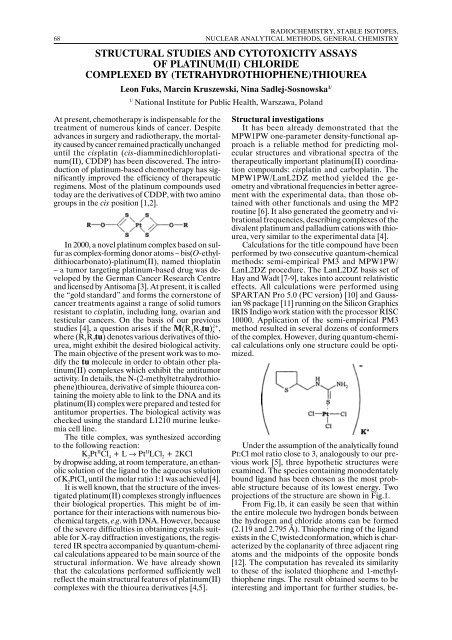annual report annual report annual report annual report 2005
annual report annual report annual report annual report 2005
annual report annual report annual report annual report 2005
Create successful ePaper yourself
Turn your PDF publications into a flip-book with our unique Google optimized e-Paper software.
68<br />
RADIOCHEMISTRY, STABLE ISOTOPES,<br />
NUCLEAR ANALYTICAL METHODS, GENERAL CHEMISTRY<br />
STRUCTURAL STUDIES AND CYTOTOXICITY ASSAYS<br />
OF PLATINUM(II) CHLORIDE<br />
COMPLEXED BY (TETRAHYDROTHIOPHENE)THIOUREA<br />
Leon Fuks, Marcin Kruszewski, Nina Sadlej-Sosnowska 1/<br />
1/<br />
National Institute for Public Health, Warszawa, Poland<br />
At present, chemotherapy is indispensable for the<br />
treatment of numerous kinds of cancer. Despite<br />
advances in surgery and radiotherapy, the mortality<br />
caused by cancer remained practically unchanged<br />
until the cisplatin (cis-diamminedichloroplatinum(II),<br />
CDDP) has been discovered. The introduction<br />
of platinum-based chemotherapy has significantly<br />
improved the efficiency of therapeutic<br />
regimens. Most of the platinum compounds used<br />
today are the derivatives of CDDP, with two amino<br />
groups in the cis position [1,2].<br />
In 2000, a novel platinum complex based on sulfur<br />
as complex-forming donor atoms – bis(O-ethyldithiocarbonato)-platinum(II),<br />
named thioplatin<br />
– a tumor targeting platinum-based drug was developed<br />
by the German Cancer Research Centre<br />
and licensed by Antisoma [3]. At present, it is called<br />
the “gold standard” and forms the cornerstone of<br />
cancer treatments against a range of solid tumors<br />
resistant to cisplatin, including lung, ovarian and<br />
testicular cancers. On the basis of our previous<br />
studies [4], a question arises if the M(R 1<br />
R 2<br />
tu) x<br />
2+<br />
,<br />
where (R 1 R 2 tu) denotes various derivatives of thiourea,<br />
might exhibit the desired biological activity.<br />
The main objective of the present work was to modify<br />
the tu molecule in order to obtain other platinum(II)<br />
complexes which exhibit the antitumor<br />
activity. In details, the N-(2-methyltetrahydrothiophene)thiourea,<br />
derivative of simple thiourea containing<br />
the moiety able to link to the DNA and its<br />
platinum(II) complex were prepared and tested for<br />
antitumor properties. The biological activity was<br />
checked using the standard L1210 murine leukemia<br />
cell line.<br />
The title complex, was synthesized according<br />
to the following reaction:<br />
K 2<br />
Pt II Cl 4<br />
+ L → Pt II LCl 2<br />
+ 2KCl<br />
by dropwise adding, at room temperature, an ethanolic<br />
solution of the ligand to the aqueous solution<br />
of K 2<br />
PtCl 4<br />
until the molar ratio 1:1 was achieved [4].<br />
It is well known, that the structure of the investigated<br />
platinum(II) complexes strongly influences<br />
their biological properties. This might be of importance<br />
for their interactions with numerous biochemical<br />
targets, e.g. with DNA. However, because<br />
of the severe difficulties in obtaining crystals suitable<br />
for X-ray diffraction investigations, the registered<br />
IR spectra accompanied by quantum-chemical<br />
calculations appeared to be main source of the<br />
structural information. We have already shown<br />
that the calculations performed sufficiently well<br />
reflect the main structural features of platinum(II)<br />
complexes with the thiourea derivatives [4,5].<br />
Structural investigations<br />
It has been already demonstrated that the<br />
MPW1PW one-parameter density-functional approach<br />
is a reliable method for predicting molecular<br />
structures and vibrational spectra of the<br />
therapeutically important platinum(II) coordination<br />
compounds: cisplatin and carboplatin. The<br />
MPW1PW/LanL2DZ method yielded the geometry<br />
and vibrational frequencies in better agreement<br />
with the experimental data, than those obtained<br />
with other functionals and using the MP2<br />
routine [6]. It also generated the geometry and vibrational<br />
frequencies, describing complexes of the<br />
divalent platinum and palladium cations with thiourea,<br />
very similar to the experimental data [4].<br />
Calculations for the title compound have been<br />
performed by two consecutive quantum-chemical<br />
methods: semi-empirical PM3 and MPW1PW/<br />
LanL2DZ procedure. The LanL2DZ basis set of<br />
Hay and Wadt [7-9], takes into account relativistic<br />
effects. All calculations were performed using<br />
SPARTAN Pro 5.0 (PC version) [10] and Gaussian<br />
98 package [11] running on the Silicon Graphics<br />
IRIS Indigo work station with the processor RISC<br />
10000. Application of the semi-empirical PM3<br />
method resulted in several dozens of conformers<br />
of the complex. However, during quantum-chemical<br />
calculations only one structure could be optimized.<br />
Under the assumption of the analytically found<br />
Pt:Cl mol ratio close to 3, analogously to our previous<br />
work [5], three hypothetic structures were<br />
examined. The species containing monodentately<br />
bound ligand has been chosen as the most probable<br />
structure because of its lowest energy. Two<br />
projections of the structure are shown in Fig.1.<br />
From Fig.1b, it can easily be seen that within<br />
the entire molecule two hydrogen bonds between<br />
the hydrogen and chloride atoms can be formed<br />
(2.119 and 2.795 Å). Thiophene ring of the ligand<br />
exists in the C s twisted conformation, which is characterized<br />
by the coplanarity of three adjacent ring<br />
atoms and the midpoints of the opposite bonds<br />
[12]. The computation has revealed its similarity<br />
to these of the isolated thiophene and 1-methylthiophene<br />
rings. The result obtained seems to be<br />
interesting and important for further studies, be-
















